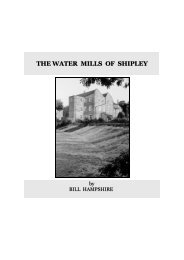IN THE SHADOW OF THE ROSSE - Shipley
IN THE SHADOW OF THE ROSSE - Shipley
IN THE SHADOW OF THE ROSSE - Shipley
You also want an ePaper? Increase the reach of your titles
YUMPU automatically turns print PDFs into web optimized ePapers that Google loves.
CHAPTER TWO<br />
Like many other towns in the increasingly industrialised West Riding, the population of<br />
<strong>Shipley</strong> had started to grow quite rapidly from the middle decades of the 19th century.<br />
This was fuelled, in the main, by an expansion in the levels of textile manufacturing<br />
production. The earliest textile mills in the town had been built close to the town centre,<br />
where most of the people lived. Later mills were built further out, on what are now<br />
called, ‘green field sites’. The largest such development in <strong>Shipley</strong> was Titus Salt’s<br />
Mill and the village of Saltaire. While the house building in Saltaire was more or less<br />
completed by the late 1860s, the population of <strong>Shipley</strong> which had increased from just<br />
over 3,000 in 1851 to 10,000 by 1869, was still increasing, and there was still a demand<br />
for more houses.<br />
It can be seen that this expansion of industrialised building only came about due to the<br />
aristocratic/gentry landowners of <strong>Shipley</strong>: the Rosses, the Crompton-Stansfields and the<br />
Wainmans, coming to recognise that their land in <strong>Shipley</strong> had greater value as building<br />
land than as agricultural land. The result was the release of a considerable amount of<br />
this land for industrial premises and house building.<br />
One of the sites chosen for disposal by the Rosses was the land at the bottom of Moorhead<br />
Lane. The three fields were divided into various blocks, and negotiations commenced<br />
concerning their development.<br />
The basic plots<br />
The first reference to any building on these three fields is in early 1869, when Charles<br />
Edwin Rhodes submitted a planning application to the <strong>Shipley</strong> Local Board of Health for<br />
the construction of a Public House at the bottom of High Bank Lane [Moorhead Lane].<br />
This was approved on the 11 th May. However, it was not until October 1869 that the<br />
Countess of Rosse finalised the sale of the plot of land of 3,100 sq yds, to Mr. Rhodes<br />
[A].<br />
Charles Edwin Rhodes was the eldest son of Edwin Rhodes, a tin-plate worker from<br />
4



